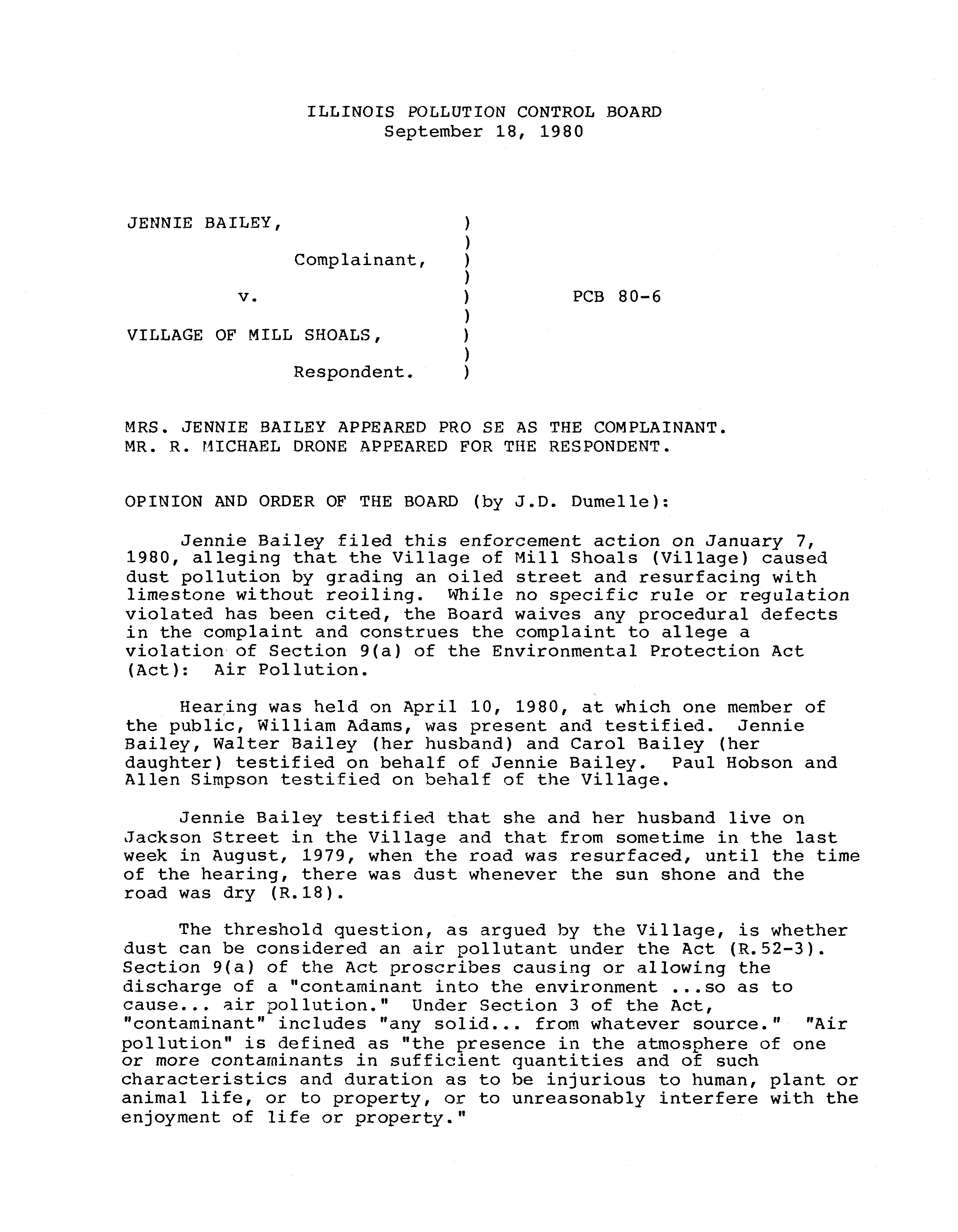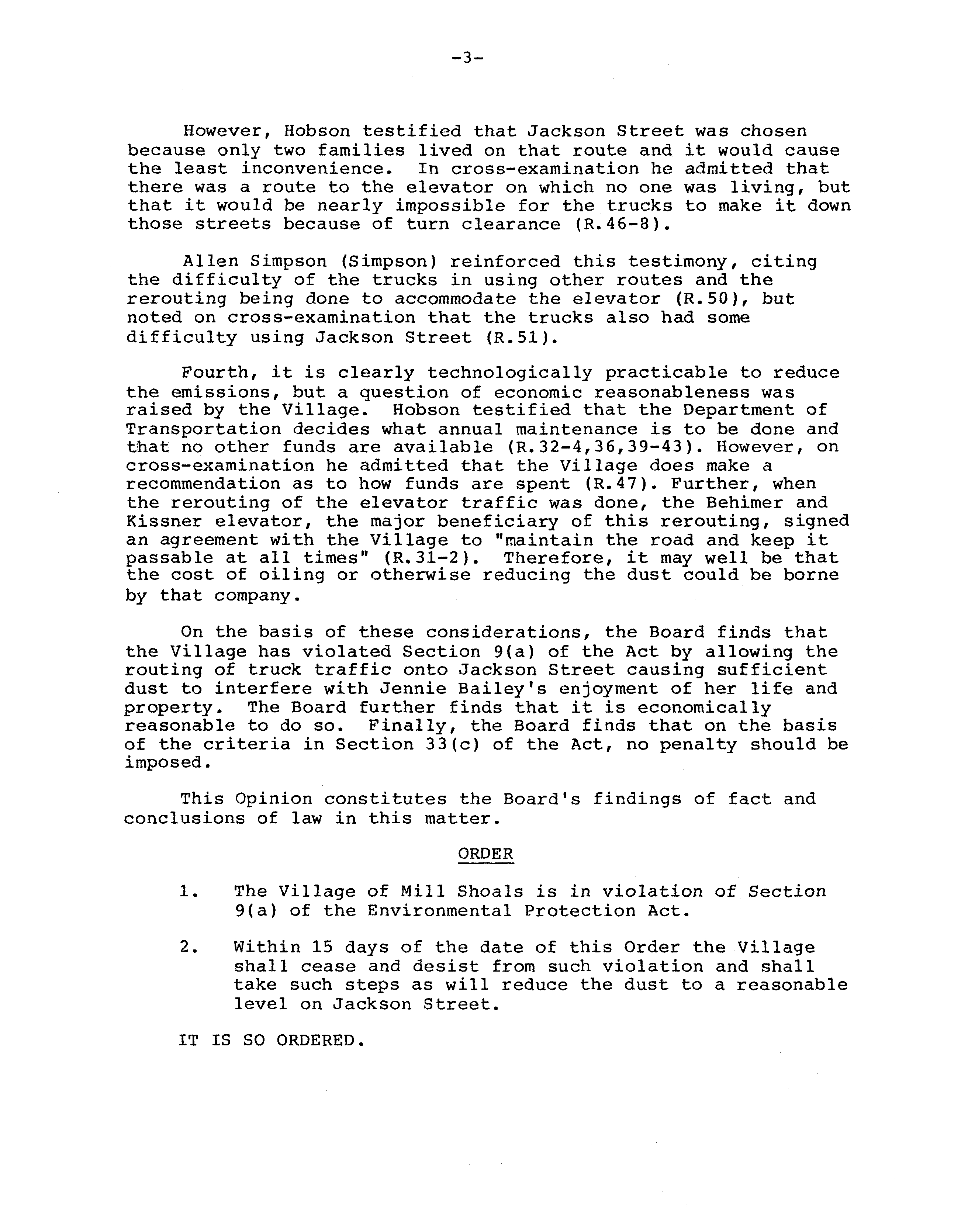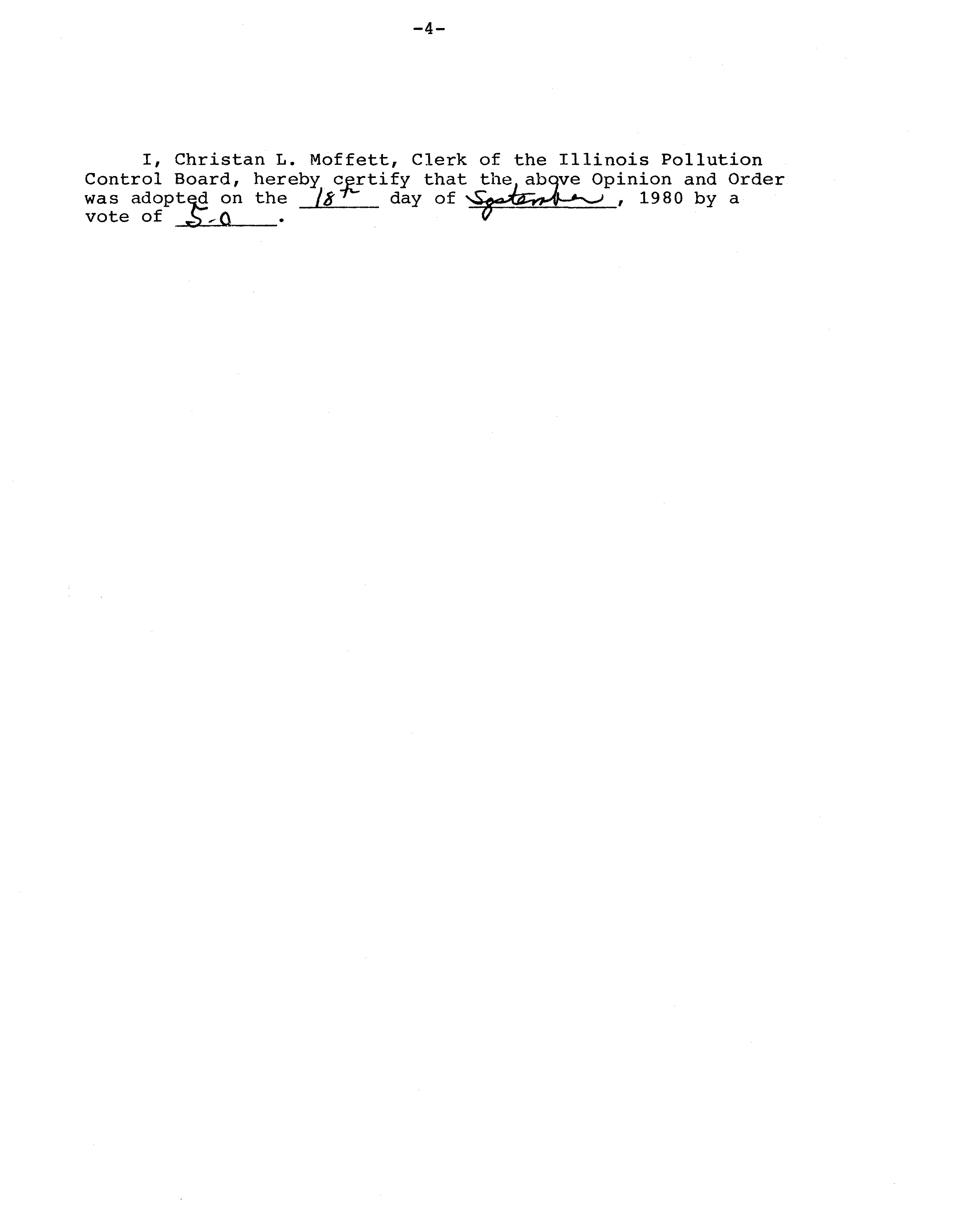ILLINOIS POLLUTION CONTROL
BOARD
September 18,
1980
JENNIE BAILEY,
Complainant,
v.
)
PCB 80—6
VILLAGE OF MILL SHOALS,
Respondent.
MRS. JENNIE BAILEY APPEARED PRO SE AS THE COMPLAINANT.
MR.
R.
MICHAEL DRONE APPEARED FOR
THE
RESPONDENT.
OPINION AND ORDER OF THE BOARD
(by J.D. Dumelle):
Jennie Bailey filed this enforcement action on
January
7,
1980, alleging that the Village of Mill Shoals (Village) caused
dust pollution by grading an oiled street and resurfacing with
limestone without reoiling.
While no specific rule or regulation
violated has been cited, the Board waives any procedural defects
in the complaint and construes the complaint to allege a
violation of Section 9(a) of the Environmental Protection Act
(Act):
Air Pollution.
Hearing was held on April
10,
1980,
at which one member of
the public, William Adams,
was present and testified.
Jennie
Bailey,
Walter Bailey
(her husband)
and Carol Bailey
(her
daughter) testified on behalf of Jennie Bailey.
Paul Hobson and
Allen Simpson testified on behalf of the Village.
Jennie Bailey testified that she and her husband live on
Jackson Street in the Village and that from sometime in the last
week in August,
1979, when the road was resurfaced,
until the time
of the hearing, there was dust whenever the sun shone and the
road was dry
(R.18).
The threshold question,
as argued by the Village,
is whether
dust can be considered an air pollutant under the Act
(R.52—3).
Section 9(a) of
the
Act proscribes causing or allowing the
discharge of a “contaminant into the environment
...so as to
cause... air pollution.”
Under Section 3 of the Act,
“contaminant” includes “any solid.., from whatever source.”
“Air
pollution” is defined as “the presence in the atmosphere of one
or more contaminants in sufficient quantities and of such
characteristics and duration as to be injurious to human, plant or
animal
life,
or
to property,
or to unreasonably interfere with the
enjoyment of life or property.”
—2—
Based on these Sections,
the Board finds that dust can be an
air pollutant, but since there has been no showing of injury to
plant or animal life or to property, the question in this case
becomes whether there has been a sufficient showing of injury to
human life or of an unreasonable interference with the enjoyment
of
life or property.
Walter Bailey testified that Jennie Bailey had to visit a
doctor because of the dust
(R.10).
Paul Hobson
(Hobson), the
Village President,
testified that he was unaware of anything in
the gravel or dust which would be injurious to human
life
(R.37),
but that testimony is accorded little weight since there was no
showing that he had any expertise in the matter.
Walter Bailey
also testified that “it is not a fit place for residence in the
condition things are in
“
(R.9).
While they have not had to move
out, even temporarily, they have had to “shut” their house and
“live under
an air conditionet”
(R.10-~11).
Neither of these
statements are rebutted.
Carol Bailey, who has periodically lived in Walter and
Jennie’s Bailey’s home, testified that the dust is caused by
large grain trucks which have been rerouted down Jackson Street
to the grain elevator
(R.25).
She further testified that during
the summer and fall these trucks run full time from very early
to very late in the day
(R.25—6).
The degree of dust is also supported by Complainant’s
Exhibits 1-7 which are photographs showing the dust caused by
trucks moving along the street.
Thus, while the injury to human life seems speculative at
best, the Board finds that there has been an interference with
the enjoyment of life and property.
The Board must next
determine whether this interference was unreasonable.
The
factors
listed
in Section 33(c) of the Act are useful in this
regard.
First,
the degree of injury or interference is not great in
terms of its scope,
i.e.
few people are affected, but it has been
substantial
in its effect on Jennie and Walter Bailey.
Second, there
is clearly social and economic value to the
cause of the source of the pollution,
Grain must be transported
and trucks are used for this purpose.
Third,
the pollution source is certainly suitable to the
area in which it is
located.
There is, however,
a question as to
whether Jackson Street, with its unoiled limestone surface is an
appropriate route to be used.
Walter Bailey testified that the
trucks were rerouted down Jackson Street because a Town Board
member’s wife’s aunt lives on the other road to the elevator
(R.23).
—3—
However, Hobson testified that Jackson Street was chosen
because only two families lived on that route and it would cause
the least inconvenience.
In cross—examination he admitted that
there was a route to the elevator on which no one was living, but
that it would be nearly impossible for the trucks to make
it down
those streets because of turn clearance
(R.46—8).
Allen Simpson (Simpson) reinforced this testimony,
citing
the difficulty of the trucks
in using other routes and the
rerouting being done to accommodate the elevator (R.50),
but
noted on cross—examination that the trucks also had some
difficulty using Jackson Street
(R.51).
Fourth, it is clearly technologically practicable to reduce
the emissions,
but a question of economic reasonableness was
raised by the Village.
Hobson testified that the Department of
Transportation decides what annual maintenance is to be done and
that no other funds are available (R.32—4,36,39—43). However, on
cross—examination he admitted that the Village does make
a
recommendation as to how funds are spent
(R.47).
Further, when
the rerouting of the elevator traffic was done,
the Behimer and
Kissner elevator,
the major beneficiary of this rerouting, signed
an agreement with the Village to “maintain the road and keep it
passable at all times”
(R.31—2).
Therefore,
it may well be that
the cost of oiling or otherwise reducing the dust could be borne
by that company.
On the basis of these considerations,
the Board finds that
the Village has violated Section 9(a) of the Act by allowing the
routing of truck traffic onto Jackson Street causing sufficient
dust to interfere with Jennie Bailey’s enjoyment of her
life and
property.
The Board further finds that it is economically
reasonable to do so.
Finally,
the Board finds that on the basis
of the criteria in Section 33(c)
of the Act, no penalty should be
imposed.
This Opinion constitutes the Board’s findings of fact and
conclusions of law in this matter.
ORDER
1.
The Village of Mill Shoals
is in violation of Section
9(a)
of the Environmental Protection Act.
2.
Within 15 days of the date of this Order the Village
shall cease and desist from such violation and shall
take such steps as will reduce the dust to a reasonable
level on Jackson Street.
IT
IS SO ORDERED,
—4—
I, Chrjstan L.
Moffett, Clerk of the Illinois Pollution
Control Board, hereby c~tifythat the ab ye Opinion and Order
~
the
/3
day of
_____________,
1980 by a





